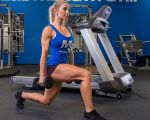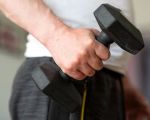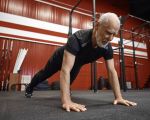- 1. What is HIIT?
- 2. Benefits of HIIT for Fat Burning
- 3. How Do HIIT Workouts Burn Fat?
- 4. Types of HIIT Workouts for Fat Loss
- 5. Real-Life Examples of HIIT Fat Loss Success
- 6. Tips for Optimizing Your HIIT Fat-Burning Workout
1. What is HIIT?
High-Intensity Interval Training (HIIT) is a popular workout technique that alternates between short bursts of intense exercise followed by brief periods of rest or low-intensity activity. HIIT has gained massive popularity in the fitness world for its ability to maximize fat burning in a short period of time. These workouts typically last between 15 to 30 minutes, making them ideal for those with a busy schedule who want to achieve fat loss and improve cardiovascular health.
Unlike traditional cardio workouts that involve steady-state activity, HIIT workouts keep your heart rate elevated and can be done with various exercises such as sprinting, cycling, bodyweight movements, or resistance training. The efficiency of HIIT makes it an attractive option for individuals looking to burn fat quickly while also improving endurance and strength.
2. Benefits of HIIT for Fat Burning
HIIT workouts are not only time-efficient, but they also provide a host of benefits for fat burning. Here are some key reasons why HIIT is particularly effective for burning fat:
- Increased Caloric Burn: HIIT workouts are known to burn more calories in less time compared to traditional cardio exercises. The high intensity of the workout leads to a greater energy expenditure during and after the session.
- Afterburn Effect (EPOC): One of the most notable benefits of HIIT is the afterburn effect, also known as Excess Post-Exercise Oxygen Consumption (EPOC). After completing a HIIT workout, your body continues to burn calories at an elevated rate for hours, helping you burn fat even after you've finished exercising.
- Improved Metabolism: The intensity of HIIT can boost your metabolism, making your body more efficient at burning fat throughout the day.
- Preserves Muscle Mass: Unlike steady-state cardio, which can lead to muscle loss over time, HIIT helps preserve lean muscle mass while burning fat. This is crucial for long-term fat loss and overall body composition.
- Time-Efficient: HIIT workouts typically take less time than traditional cardio exercises. This makes it easier to fit fat-burning sessions into a busy lifestyle without sacrificing effectiveness.
3. How Do HIIT Workouts Burn Fat?
HIIT workouts are effective at burning fat due to their intense nature, which forces your body to work harder and faster. During high-intensity intervals, your body uses glycogen (stored carbohydrates) for energy. However, when you engage in the rest periods, your body taps into fat stores to fuel recovery and sustain the workout. This combination of energy use promotes fat loss in several ways:
3.1. Increased Heart Rate and Fat Burning
As you push your body to its limits during high-intensity intervals, your heart rate increases significantly. This elevated heart rate helps burn fat more efficiently during the workout and leads to more fat being used for energy in the recovery phase.
3.2. Hormonal Response
HIIT workouts trigger the release of hormones like human growth hormone (HGH) and adrenaline, both of which are involved in fat loss. These hormones help to accelerate fat burning, increase metabolic rate, and promote fat oxidation, all of which contribute to fat loss.
3.3. Preservation of Muscle Mass
Since HIIT exercises typically involve compound movements that engage multiple muscle groups, they help to preserve lean muscle mass while burning fat. Maintaining muscle mass is essential for achieving a toned, defined physique, and it also contributes to a higher resting metabolic rate.
4. Types of HIIT Workouts for Fat Loss
HIIT workouts can be customized to suit individual fitness levels and preferences. There are many types of HIIT workouts that target fat loss effectively. Below are some popular options:
4.1. Bodyweight HIIT
Bodyweight HIIT exercises use no equipment, making them accessible and easy to do anywhere. Examples include squats, burpees, jumping jacks, and mountain climbers. Bodyweight HIIT workouts are excellent for improving overall fitness and burning fat without needing a gym membership or specialized equipment.
4.2. Cycling HIIT
Cycling HIIT involves alternating between sprinting at full intensity on a stationary bike and recovering at a slower pace. This type of HIIT is great for those who prefer cardio workouts and want to target fat loss while improving leg strength and cardiovascular health.
4.3. Tabata Training
Tabata training is a specific form of HIIT that involves 20 seconds of high-intensity exercise followed by 10 seconds of rest, repeated for 4 minutes (8 rounds). Tabata is an excellent fat-burning workout for those looking to maximize results in a short period of time.
4.4. Resistance Training HIIT
Resistance training HIIT combines strength exercises (like squats, lunges, and push-ups) with high-intensity intervals. This workout is perfect for those looking to burn fat while building muscle, as it incorporates both cardio and strength training components.
5. Real-Life Examples of HIIT Fat Loss Success
Many individuals have achieved impressive fat loss results through consistent HIIT training. Take, for example, Sarah, who struggled with losing weight after pregnancy. After incorporating HIIT into her fitness routine for just 20 minutes a few times a week, she was able to shed excess fat, tone her body, and increase her energy levels. Her success story is a testament to the effectiveness of HIIT workouts in burning fat and improving overall fitness.
Another example is Tom, who was able to reduce his body fat percentage significantly after committing to a 30-day HIIT challenge. Tom incorporated both cycling and bodyweight exercises into his routine and saw rapid improvements in fat loss, strength, and endurance.
6. Tips for Optimizing Your HIIT Fat-Burning Workout
To get the most out of your HIIT workouts and maximize fat burning, consider these tips:
- Consistency: Stick to your HIIT routine for at least 3-4 sessions per week. Consistency is key for seeing significant fat loss results.
- Intensity: Push yourself during the high-intensity intervals. The more effort you put in, the more calories and fat you will burn.
- Rest: Don’t skip the rest intervals. The recovery period is crucial for your body to repair and continue burning fat.
- Combine with Proper Nutrition: Fuel your body with a balanced diet that supports fat loss. Prioritize whole foods and maintain a slight calorie deficit to achieve optimal results.
- Progressive Overload: Gradually increase the intensity or duration of your HIIT workouts to continue challenging your body and promote fat loss.








